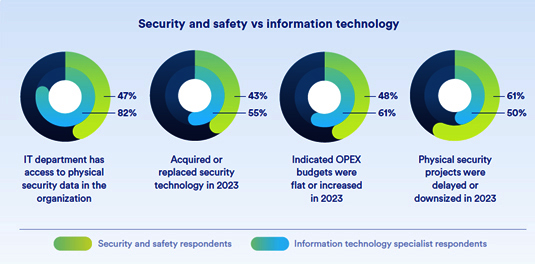
Anand Thirunagari
India Country Manager, Genetec
2024 Trends in the Physical Security Industry for the General and India Physical Security Market
As we navigate the dynamic landscape of physical security trends in 2024, we observe organizations in India making a strong push for the convergence of IT and physical security teams. The demand for cloud solutions is rising, and access control modernization has become a top priority. Breaking down silos between different physical security systems such as CCTV and access control, is an integral part of the refresh/ design discussions. Data from IIoT devices and its convergence with physical security are the most sought-after requirements in critical infrastructure.
In the pursuit of a resilient and secure future, Indian companies are likely to prioritize access control modernization, unifying physical security systems in the areas of CCTV, access control, IIOT, and PIDS systems. Hybrid-cloud adoption, with the feasibility of moving the access control system to the cloud, is anticipated. Embracing open access control solutions and optimizing cloud spending will enhance operational efficiencies. Simultaneously, aligning with stringent data protection requirements and implementing advanced cybersecurity tools ensures a robust defense against evolving threats. These strategic measures not only bolster our physical security but also underscore our commitment to organizational continuity and community safety.
#1 Access control modernization will top tech investments
Modernizing access control will remain a top priority in 2024. To ease upgrade complexities, many organizations will shift to a hybrid-cloud model and deploy cloudready access control solutions. This will deliver continuous innovation and cybersecurity updates that reinforce security from doors to networks.
We’ll also see greater demand for open access control solutions. More than ever, organizations want the freedom to add and connect the best technologies out there. In 2024, this will include everything from building management systems and life and safety solutions to human resource management software and mobile credentials to name a few.
Unifying access control with these various technologies can boost operational efficiencies and sustainability initiatives. They also allow employers to enhance the cardholder experience; one where everything feels more fluid and convenient.
Many will also reach a breaking point in managing separate video and access control systems. Striving for more efficiencies, leaders will take steps towards system unification. This will simplify system monitoring and maintenance tasks, leading to higher output and costs savings across the enterprise.
#2 Businesses will focus on maximizing hybrid-cloud investments
The physical security industry will see a large increase in hybrid-cloud adoption in 2024. Recent research found that 44% of organizations already have over a quarter of their physical security deployment in a cloud or hybrid-cloud environment.
As cloud adoption rises, there’s a growing interest in new plug-and-play, cloud-ready appliances. They not only streamline access to cloud services but also enhance computing power at the edge.
We’ll also see a larger focus on cloud data usage and associated costs. Those who are further along in their hybrid-cloud journey are seeking ways to optimize cloud spend. Many will lean on channel partners to explore use cases beyond security to maximize hybrid-cloud investments.
#3 IT and physical security teams will join forces
Physical security’s convergence with IT is accelerating. And it isn’t limited to technology anymore. In the coming year, organizations will look to optimize collaboration between IT and physical security teams. Bridging these two valuable skill sets will result in more effective risk mitigation and data optimization across the organization. And though there’s no one-size- fits-all approach, most will consider the following strategies:
- Physical security leaders will expand their departments with IT expertise.
- Security Operations (SecOps) will broaden their function to address physical security risks and capitalize on data coming from both groups.
- IT will bring physical security within their group and begin overseeing physical security mandates.

As this human-centered convergence grows, so will the demand for unified, cloud-connected physical security solutions. This will give teams a comprehensive view of systems and evolving risks while helping them extract more value from data.
#4 IIoT growth and data-optimized solutions will boom
The number of physical security devices and other Industrial Internet of Things (IIoT) sensors coming into the market is accelerating. And across industries, organizations can’t get enough. IT and security experts want to expand the types of data within their security deployment. Beyond that, they’re looking to extract data from the systems holding it and build data lakes that serve future objectives.
At this critical moment, those who opt for an API-centric, open architecture, along with a unified physical security platform will stand to gain the most over time. This will give them the flexibility to combine and simultaneously analyze various sources of data on their own terms. Ultimately this can help inform new data-driven strategies and maximize returns across all tech investments.
During this data influx, many organizations will also look for ways to empower their operators and digitize current workflows. As a result, demand for physical security solutions with embedded analytics, automation tools, and visual dashboards will grow.
Over 5,500 physical security professionals answered our annual survey this year.
Get the free report to gain comprehensive insights on the industry’s transition to SaaS, the convergence between IT and physical security, the impact of the manpower shortage, and more.
*Views expressed in the article are solely of the Author
![]()